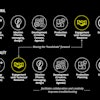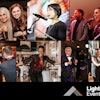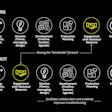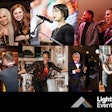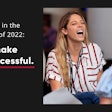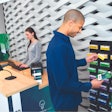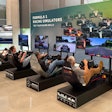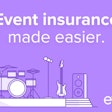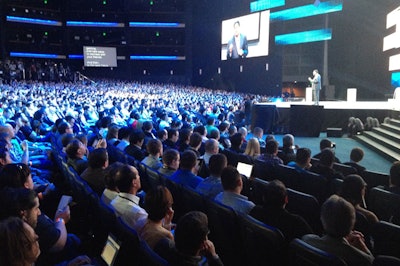
Fast, free, reliable Wi-Fi is no longer an optional perk for convention and trade show attendees; it’s an expectation. According to Nielsen, there are now 84 million smartphone users in the United States, and many users also carry a second device such as a tablet or laptop. On one hand, the ubiquitous nature of this technology creates opportunities for planners, like generating more buzz for events by encouraging attendees to share live posts to Twitter, Instagram, Facebook, and other social networks. But this hyper-connectivity also creates an added item on a planner’s to-do list: ensuring there is a fast, free Wi-Fi network that can handle the load of the event.
Ian Framson is co-founder and C.E.O. of Trade Show Internet, a company that provides Internet access for meetings, conferences, and trade shows. We asked Framson to share his thoughts on some of the most important things planners should keep in mind when planning how to offer Internet connectivity to attendees.
1. For large events, Wi-Fi will likely come with a cost.
Many planners expect Wi-Fi to be a utility provided by the venue just like water, clean air, or power. They want it everywhere, and they want it free. That approach may work for a smaller or a less technical event. If you are just looking for a hotspot in the café or to say you have some level of service, you can get away with it, and a property can give it to you as a service. The problem is when you have 1,000, 10,000, or 100,000 people, and you have a massive expo hall and breakouts and foyers and a meal hall. You start talking about a level of infrastructure that can no longer be free because of the cost to set up that infrastructure and the salaries of the I.T. staff to maintain it and monitor it. It's not cheap. The facility has to recoup it somewhere; they are not running a nonprofit.
2. The cost of Wi-Fi will vary from event to event.
Wi-Fi costs are related to the scale and scope of the event. If you have 100 people or 100,000 people, that’s a totally different scale. You need more infrastructure, more bandwidth, and probably a few more engineers present to provide support, so you should expect the cost to go up commensurately. A lot of planners don’t properly budget for it. They assume it will be an amenity included for free and is sort of an afterthought. So the best thing to do from a planner's perspective is to look at the scope of your event and what attendees’ expectations are. Are you using 10,000 square feet or 100,000 square feet? Which rooms are you using? How will you use the space? And how many devices are attendees bringing?
3. Consider how attendees will use the Wi-Fi.
In addition to the number of devices per person, another important thing to consider is the content and how attendees are using those devices. For example, if a software company invites its sales reps to come in for training, you might have a speaker in a room who says, "We are going to go through this training course. I want all of you to pull out your laptops and follow along with me." Having 200 people use Wi-Fi for an intensive training seminar is a totally different use of the network than a conference where people are causally checking email or posting to Facebook. So knowing how many devices people bring is only half of the equation. Knowing the use of the content and how frequently attendees will be using the network is the other side.
4. Consider how long attendees will be at your event.
If you are asking attendees to dedicate three days of their life to your event, and you are expecting them to just rely on their cellular plan, only their cell phones will work. Most people don’t have a cellular plan for their iPad or laptop, and they are going to be relying on the conference’s Wi-Fi network to stay productive. The worst thing you can tell an attendee is, "Hey, come to my event for three days, but you are not going to be connected to the outside world. You’ll have to wait until you get to your hotel room at night to check email." That’s crazy. So I think planners are starting to realize that their attendees have needs beyond just water and food and things like that. Wi-Fi is one of those basic needs.
5. Shop around for the best Wi-Fi service and negotiate early on.
It’s the same thing as audiovisual or any other service categories where the default in the contract is typically for the facility to be the exclusive. Savvier planners are negotiating each category to make it open rather than exclusive. It doesn’t mean they are not going to use the facility, it just means they have options. And they can hold the facility accountable and make sure they are getting a competitive service. We can deploy a robust Wi-Fi network that rivals anything in any facility, but we can’t do it unless the meeting planner negotiates in advance for the right to do that. A lot of time, Wi-Fi is an afterthought. I get these frantic phone calls from planners saying they signed the contract two years ago, and now they are one month before their event, and the venue says here is what we have and it will cost $80,000. They’ve lost their economic bargaining advantage. So negotiate up front to make everything open, and bring in your total group spend so you are negotiating with the full weight of your power.
6. When executed properly, Wi-Fi can provide a measurable ROI.
We did a product launch event for Nintendo at E3. Nintendo is heavily invested in social media. They encourage gamers and bloggers to live stream from their events. Their attendees are the younger generations—they are that hyper-connected, on-demand generation. When you bring 4,000 of them to a Nintendo event, not having Wi-Fi is just crucifying yourself. So Nintendo planned in advance. The facility [Nokia Theatre] acknowledged it couldn’t support 4,000 people on Wi-Fi. So Nintendo got in touch with us, and we planned months in advance to build a network to match the scope of the event. And they also allocated a meaningful budget, which for them was about $40,000 just for the Wi-Fi network. The result was that everybody live streamed and live blogged the event. You had product announcements going viral in real time on Facebook and Twitter. They were really able to catalyze their user base and give them a megaphone and empower them to take that message live the moment it launched. I think they got a significant social buzz because of the way they took care of their attendees and provided for their connectivity needs.

